
Georges Carpentier was a French boxer, actor and World War I pilot. He fought mainly as a light heavyweight and heavyweight in a career lasting from 1908 to 1926. Nicknamed the "Orchid Man", he stood 5 feet 11+1⁄2 inches (182 cm) and his fighting weight ranged from 147 to 175 pounds. Carpentier was known for his speed, his excellent boxing skills and his extremely hard punch. The Parisian Sports Arena Halle Georges Carpentier is named after him.
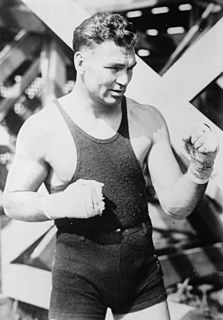
William Harrison "Jack" Dempsey, nicknamed Kid Blackie and The Manassa Mauler, was an American professional boxer who competed from 1914 to 1927, and reigned as the world heavyweight champion from 1919 to 1926. A cultural icon of the 1920s, Dempsey's aggressive fighting style and exceptional punching power made him one of the most popular boxers in history. Many of his fights set financial and attendance records, including the first million-dollar gate. He pioneered the live broadcast of sporting events in general, and boxing matches in particular.

Luis Ángel Firpo was an Argentine boxer. Born in Junín, Argentina, he was nicknamed The Wild Bull of the Pampas.
Boxing in the 1920s was an exceptionally popular international sport. Many fights during this era, some 20 years away or so from the television era, were social events with many thousands in attendance, both men and women.

James Walter Braddock was an American boxer who was the world heavyweight champion from 1935 to 1937.
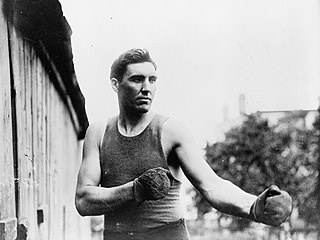
Jess Myron Willard was an American world heavyweight boxing champion billed as the Pottawatomie Giant who knocked out Jack Johnson in April 1915 for the heavyweight title. Willard was known for size rather than skill, and though held the championship for more than four years, he defended it rarely. In 1919, when he was 37 years of age he lost the title in an extremely one sided loss by declining to come out for the fourth round against Jack Dempsey, who became a more celebrated champion. Soon after the bout Willard began accusing Dempsey of using something with the effect of a knuckle duster. Dempsey did not grant Willard a return match, and at 42 years old he was KO'd, following which he retired from boxing, although for the rest of his life continued claiming Dempsey had cheated. Ferdie Pacheco expressed the opinion in a book that the surviving photographs of Willard's face during the Dempsey fight indicate fractures to Willard's facial bones suggesting a metal implement, and show he was bleeding heavily. The matter has never been resolved, with contemporaneous ringside sports journalist reporting by the NYT that Willard spat out at least one tooth and was "a fountain of blood" increasingly discounted in favor of a view that he had only a cut lip and a little bruising.
The Jack Dempsey versus Luis Ángel Firpo fight was a historic boxing fight: It was the first time that a Latin American fighter would challenge for the world heavyweight title, and it would be one of the defining fights of Dempsey's career.

George Lewis "Tex" Rickard was an American boxing promoter, founder of the New York Rangers of the National Hockey League (NHL), and builder of the third incarnation of Madison Square Garden in New York City. During the 1920s, Tex Rickard was the leading promoter of the day, and he has been compared to P. T. Barnum and Don King. Sports journalist Frank Deford has written that Rickard "first recognized the potential of the star system." Rickard also operated several saloons, hotels, and casinos, all named Northern and located in Alaska, Nevada, and Canada.

The Jack Dempsey vs. Tommy Gibbons fight was a bout for boxing's world heavyweight title. It was held on July 4, 1923, in the town of Shelby, Montana, USA.
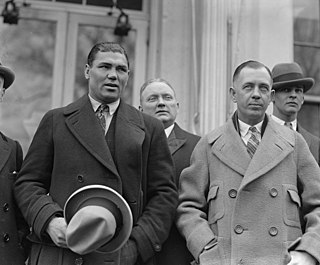
Jack "Doc" Kearns was an American boxer and boxing manager. He was born on a farm in Waterloo, Michigan to Phillip H. McKernan and Frances M. Knauf, daughter of German immigrant and Waterloo, Michigan, settler Peter Knauf. His father was the son of Irish immigrants Philip and Amelia "Ann" McKernan and is noted as being "among the early pioneers in the Northwestern Territories of Montana, Idaho and Washington."

Bill Brennan was an American boxer who fought and lost to World Heavyweight Champion Jack Dempsey in a well attended title fight that ended in a twelfth-round knockout on December 14, 1920, in Madison Square Garden. He lost to Dempsey for the first time in a non-title fight on February 5, 1918, in Milwaukee, Wisconsin, in a sixth-round technical knockout.

Barney Lebrowitz, better known as Battling Levinsky, was an American boxer who was the world light heavyweight champion from 1916 to 1920. Statistical boxing website BoxRec lists Levinsky as the #12 ranked light heavyweight of all-time, while The Ring Magazine founder Nat Fleischer placed him at #9. The International Boxing Research Organization rates Levinsky as the 20th best light heavyweight ever. He was inducted into the Ring Magazine Hall of Fame in 1966, the International Jewish Sports Hall of Fame in 1982, and the International Boxing Hall of Fame in 2000.
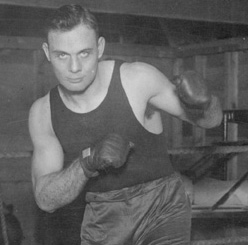
Floyd Johnson, nicknamed "The Auburn Bulldog", was an American heavyweight boxer who was known for his stiff punch. His (incomplete) boxing record comes out to: 38 wins, 13 losses, and 11 draws. In 1923, he was considered a leading contender, and described in Time magazine as "possibly the fifth-best heavyweight in the ring." His manager was Alec Greggains. After his boxing career ended, he went into promotion in White Center, Washington. and served as a deputy sheriff in King County, Washington in the mid-1920s.
Gate receipts, or simply "gate", is the sum of money taken at a sporting venue for the sale of tickets.

Joseph "Joe" Edward Humphreys was an American boxing official and announcer. He was one of the most popular fight announcers from the turn of the 20th century up until the 1930s. In his near 50-year career, Humphreys was estimated to have announced over 20,000 boxing matches and officiated many of the top prize fights of the era as the longtime official ring announcer at the old Madison Square Garden from 1925 up to his death in 1936.
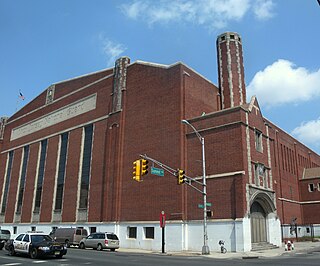
The Jersey City Armory is located at 678 Montgomery Street near McGinley Square in Jersey City, New Jersey. In addition to being a military training and mustering facility of the New Jersey National Guard, the WPA era armory has long been used as a sports arena, particularly for boxing, basketball, and track and field events, and more recently mixed martial arts.
The Hurley Boxing Law was a law passed in New Jersey in 1918 that legalized boxing in the state for the first time.
The White Heavyweight Championship was a title in pretense created when the "White Hopes" of the time that African-American Jack Johnson was the world heavyweight champion had failed to wrest the title from him after four and one-half years. The first of the Great White Hopes, former world heavyweight champ James J. Jeffries had failed to vanquish Johnson in 1910, leading to an elimination tournament of "White Hopes" in New York City in 1911.

Jack Dempsey vs. Georges Carpentier was a boxing fight between world heavyweight champion Jack Dempsey and world light-heavyweight champion Georges Carpentier, which was one of the fights named the "Fight of the Century". The bout took place in the United States on Saturday, July 2, 1921, at Boyle's Thirty Acres in Jersey City, New Jersey.
WJY was a temporary longwave radio station, located in Hoboken, New Jersey and operated by the Radio Corporation of America (RCA), which was used on July 2, 1921 for a ringside broadcast of the Dempsey-Carpentier heavyweight boxing match.

















